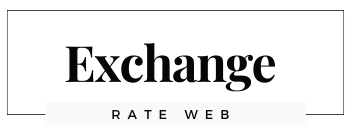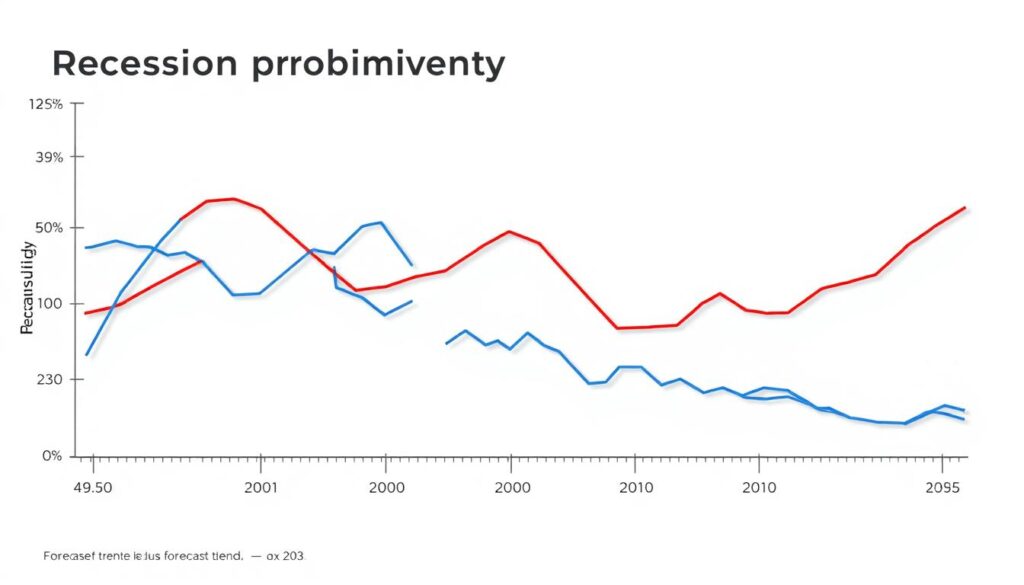
Economic forecasts for 2025 are showing mixed signals, with several leading indicators pointing to potential economic turbulence ahead. While some experts have reduced their recession probability estimates, others warn that policy shifts, inflation concerns, and global trade tensions could still trigger a significant downturn. This comprehensive analysis examines the latest predictions, identifies key risk factors, and provides actionable strategies to help individuals and businesses prepare for potential economic challenges.
Current Recession Forecasts for 2025
Recent economic analyses present varying perspectives on the likelihood of a 2025 recession. Understanding these forecasts provides crucial context for financial planning.
Economic forecasts show varying recession probabilities for 2025
Major Financial Institutions’ Outlooks
J.P. Morgan Research has recently reduced the probability of a U.S. and global recession occurring in 2025 from 60% to 40%. This adjustment reflects easing trade tensions and more optimistic economic indicators. However, they still caution that “a period of sub-par growth could lie ahead, especially as the U.S. tariff shock could still be material.”
Deloitte’s economic team has developed three potential scenarios for the U.S. economy, with their baseline forecast projecting real GDP growth of just 1.4% in 2025 and 1.5% in 2026. Their downside scenario includes the possibility of a recession beginning in late 2025, with GDP potentially falling 1.7% in 2026.
“We no longer see a U.S. recession, but expect material headwinds to keep growth weak through the rest of this year.”
Academic and Independent Forecasts
The UCLA Anderson Forecast has announced a “Recession Watch” for 2025-2026, noting that while there are no signs of an imminent recession, certain policy initiatives could trigger enough sectors of the economy to contract simultaneously. Their analysis suggests that if multiple proposed policies are fully enacted, a recession becomes increasingly likely.
Independent economists surveyed by Bloomberg place the probability of a recession within the next 12 months at approximately 35%, down from earlier estimates but still representing significant risk.
Key Risk Factors That Could Trigger a 2025 Recession
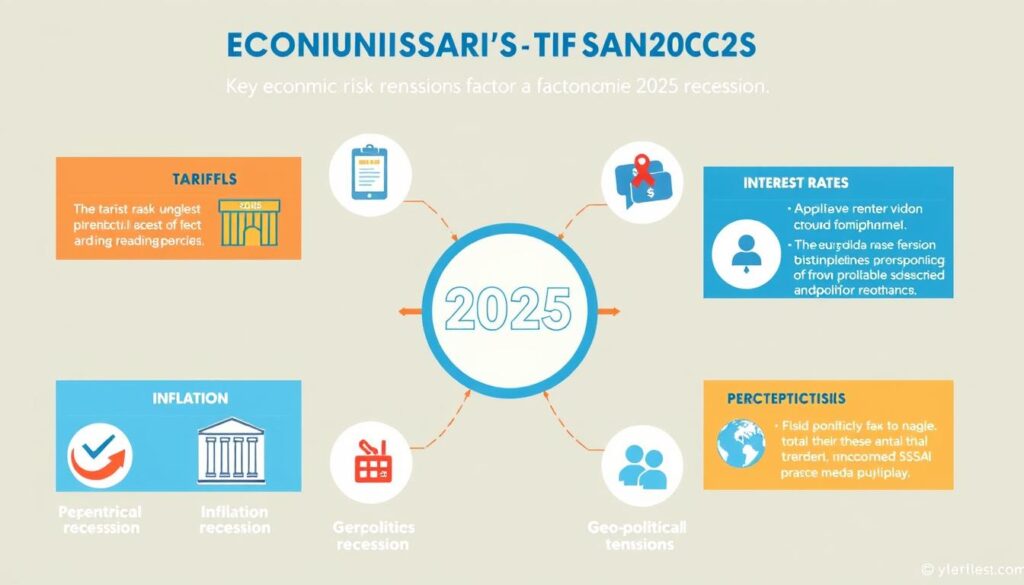
Trade Policies and Tariffs
Trade tensions and tariff policies represent one of the most significant recession risk factors. According to Deloitte’s analysis, if the average tariff rate rises to about 25% as negotiations for new trade agreements stall, it could significantly impact economic growth. Higher tariffs would effectively function as a tax on U.S. households and businesses, potentially worth up to 1.4% of GDP.
The impact would be particularly pronounced in manufacturing, retail, and agricultural sectors due to highly integrated cross-border supply chains. As UCLA Anderson economist Clement Bohr notes, “The tariff policy and ensuing trade wars will likely lead to a contraction in the manufacturing sector.”
Monetary Policy and Interest Rates
The Federal Reserve’s approach to interest rates will play a crucial role in determining economic outcomes. Most forecasts expect the Fed to hold rates steady in the near term, with potential cuts beginning in late 2025. However, if inflation persists due to tariffs or other factors, the Fed may delay rate cuts or even implement further increases.
J.P. Morgan projects that “the Fed is not expected to start easing until December, with three sequential cuts thereafter, reaching a policy rate of 3.25–3.5% by the second quarter of 2026.” This cautious approach could extend the period of higher borrowing costs for businesses and consumers.
Inflation Pressures
Inflation remains a significant concern, with core inflation proving more persistent than headline figures suggest. Deloitte forecasts that “with an acceleration in prices due to tariffs, we expect CPI growth to average 2.9% in 2025 and accelerate to 3.2% in 2026.”
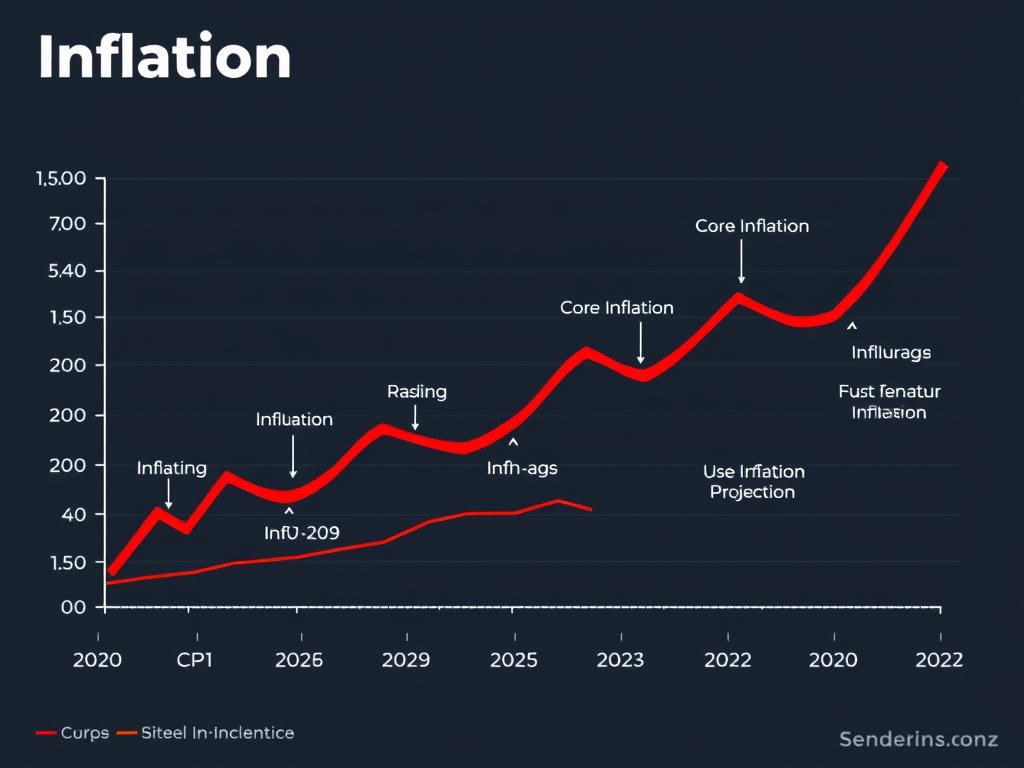
Rising inflation expectations could further complicate the economic picture. The University of Michigan’s consumer survey showed forward inflation expectations rising to 5.1% in June from 3.3% in January, suggesting consumers are preparing for higher prices ahead.
Government Policy and Fiscal Concerns
Fiscal policy decisions, including tax provisions and government spending, will significantly impact economic outcomes. The extension of tax provisions and potential additional tax cuts could provide short-term stimulus but may worsen long-term debt concerns.
Budget deficits are projected to remain elevated, with Deloitte estimating “the federal budget deficit will rise to 6.4% of GDP in 2025 from 6.2% in 2024.” This fiscal situation could eventually lead to higher borrowing costs if bond markets react negatively to mounting government debt.
Labor Market Weaknesses
While unemployment remains relatively low at around 4.2%, early warning signs are appearing in the labor market. Job cut announcements have increased, and the number of people claiming unemployment insurance has begun to rise. Deloitte projects the unemployment rate could increase to 4.6% by 2026 in their baseline scenario.
How to Prepare for a Potential 2025 Recession

With economic uncertainty on the horizon, taking proactive steps to strengthen your financial position is essential. The following strategies can help individuals and businesses mitigate recession risks.
Get Your Free Recession Preparation Checklist
Download our comprehensive guide with 25 actionable steps to protect your finances before, during, and after a recession.
For Individuals and Households
Build Your Emergency Fund
Financial experts recommend maintaining an emergency fund covering 6-9 months of essential expenses during uncertain economic times. This provides a crucial buffer against potential job loss or income reduction.
Consider keeping these funds in high-yield savings accounts or short-term Treasury bills to maintain liquidity while earning some return.
Reduce High-Interest Debt
With interest rates remaining elevated, prioritize paying down high-interest debt, particularly credit cards and personal loans. This reduces your monthly obligations and improves cash flow flexibility during economic downturns.
Consider debt consolidation options if you can secure lower interest rates, but be cautious about extending repayment terms unnecessarily.
Diversify Investment Portfolio
Review your investment allocations to ensure appropriate diversification across asset classes, sectors, and geographies. Consider increasing allocations to defensive sectors like consumer staples, healthcare, and utilities.
Treasury bonds, high-quality corporate bonds, and dividend-paying stocks have historically provided more stability during economic contractions.
Enhance Your Skills and Employability
Recession periods often bring workforce reductions. Invest in developing in-demand skills that increase your value to current and potential employers. Consider certifications, continuing education, or expanding your professional network.
Review and Adjust Your Budget
Identify non-essential expenses that can be reduced or eliminated if necessary. Creating a “recession budget” in advance helps you understand how to quickly adapt your spending if economic conditions deteriorate.
Consider Housing Costs
Housing typically represents the largest expense for most households. If you’re considering buying property, be cautious about taking on maximum debt levels. For renters, understand your lease terms and consider negotiating longer-term agreements if rates are favorable.
For Businesses and Entrepreneurs

Strengthen Cash Reserves
Businesses should prioritize building cash reserves to weather potential revenue declines. Aim for at least 3-6 months of operating expenses in liquid assets, depending on your industry’s sensitivity to economic cycles.
Review Supply Chain Resilience
With tariff uncertainties and potential trade disruptions, assess your supply chain vulnerabilities. Identify alternative suppliers, consider reshoring critical components, and review inventory management strategies to balance cost efficiency with resilience.
Optimize Operating Costs
Conduct a thorough review of operating expenses to identify potential efficiencies without compromising quality or service. Consider renegotiating contracts with vendors and suppliers while economic conditions remain favorable.
Secure Financing Options
If your business may need capital during a downturn, consider securing credit lines or financing while terms remain favorable. Waiting until economic conditions deteriorate often results in tighter lending standards and higher costs.
Diversify Revenue Streams
Businesses with multiple revenue sources typically demonstrate greater resilience during economic contractions. Explore opportunities to expand your product or service offerings, enter new markets, or develop recurring revenue models.
Invest in Customer Retention
During recessions, retaining existing customers becomes even more critical. Develop strategies to enhance customer loyalty and satisfaction, as acquiring new customers typically becomes more challenging and expensive during downturns.
Investment Strategies for Uncertain Economic Times
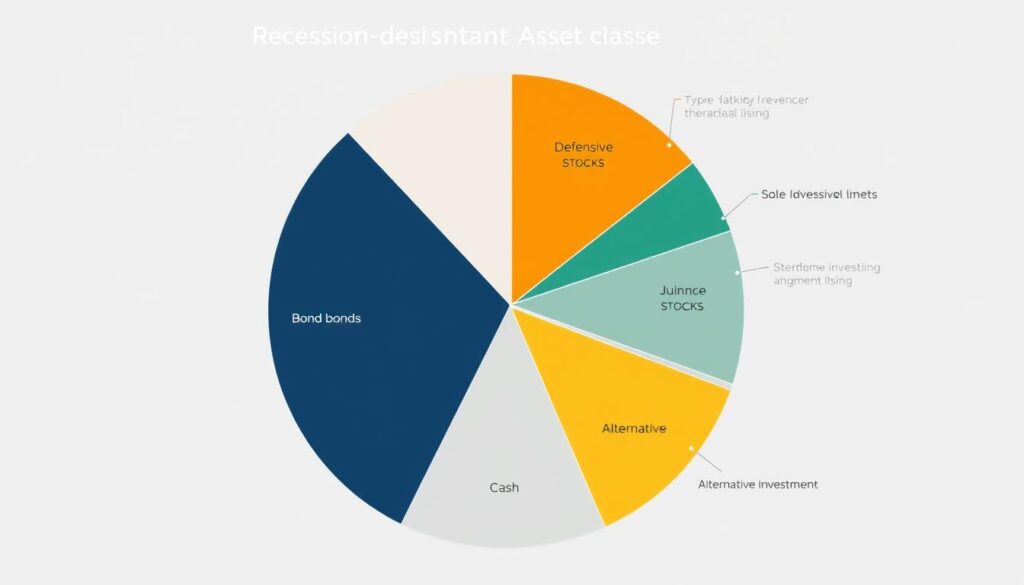
Adjusting your investment approach ahead of potential economic turbulence can help protect capital while positioning for eventual recovery. Consider these strategies based on your risk tolerance and time horizon.
Defensive Asset Allocation
During periods of economic uncertainty, investors often benefit from increasing allocations to traditionally defensive assets. Consider these allocation adjustments based on your risk profile:
| Asset Class | Traditional Allocation | Defensive Allocation | Key Considerations |
| U.S. Treasury Bonds | 20-30% | 30-40% | Focus on short to intermediate duration to manage interest rate risk |
| Defensive Equities | 30-40% | 20-30% | Emphasize quality companies with strong balance sheets and stable cash flows |
| Cash/Money Market | 5-10% | 15-20% | Provides liquidity and opportunity capital for market dislocations |
| Gold/Precious Metals | 0-5% | 5-10% | Traditional hedge against inflation and currency devaluation |
| International Developed Markets | 15-20% | 10-15% | Consider markets with less exposure to U.S. economic cycles |
| Emerging Markets | 10-15% | 5-10% | Higher volatility during global economic stress; be selective |
Sector Positioning
Certain sectors typically demonstrate greater resilience during economic contractions. Consider increasing exposure to:
- Consumer Staples: Companies producing essential goods with inelastic demand
- Healthcare: Necessary services with relatively stable demand patterns
- Utilities: Essential services with regulated returns and stable cash flows
- Telecommunications: Critical infrastructure with subscription-based revenue models
- Select Technology: Companies providing essential business services and infrastructure
Conversely, consider reducing exposure to highly cyclical sectors such as consumer discretionary, industrials, and materials, which typically underperform during economic contractions.
Alternative Investment Considerations
Beyond traditional stocks and bonds, certain alternative investments may provide diversification benefits during economic uncertainty:
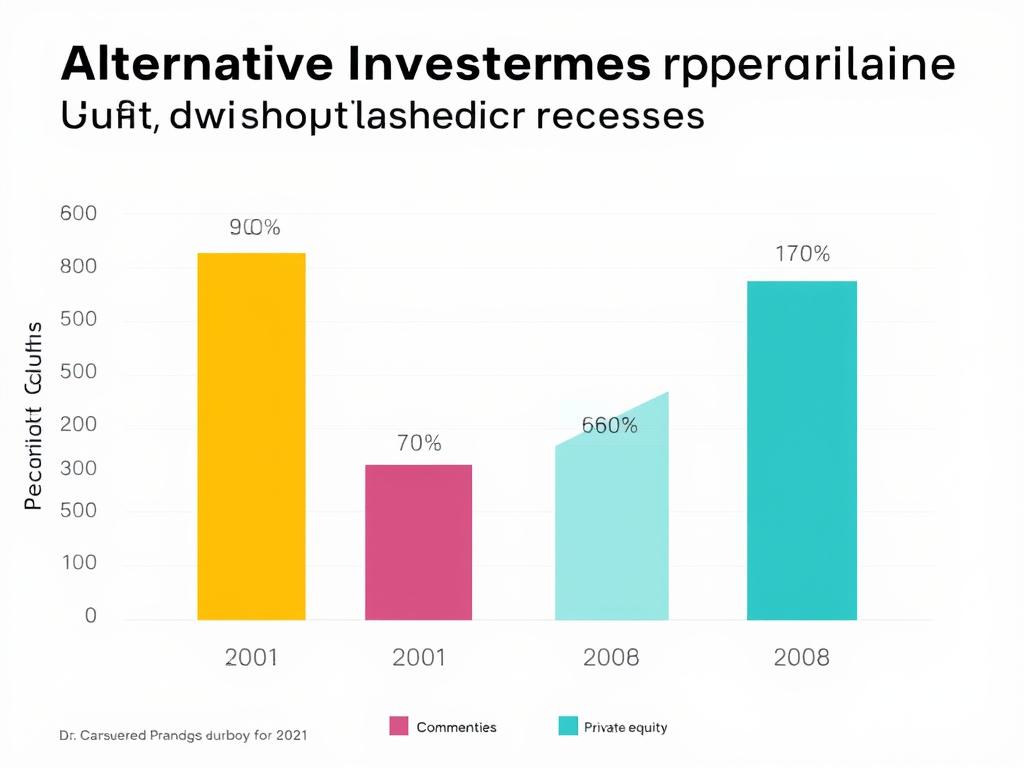
- Real Estate Investment Trusts (REITs): Focus on essential property types like data centers, healthcare facilities, and storage
- Infrastructure: Assets with long-term contracts and essential services
- Hedge Funds: Strategies with lower correlation to traditional markets
- Private Credit: Potential for higher yields with structural protections
Important Note: Investment strategies should be tailored to your specific financial situation, goals, and risk tolerance. Consider consulting with a financial advisor before making significant portfolio changes.
Key Economic Indicators to Monitor
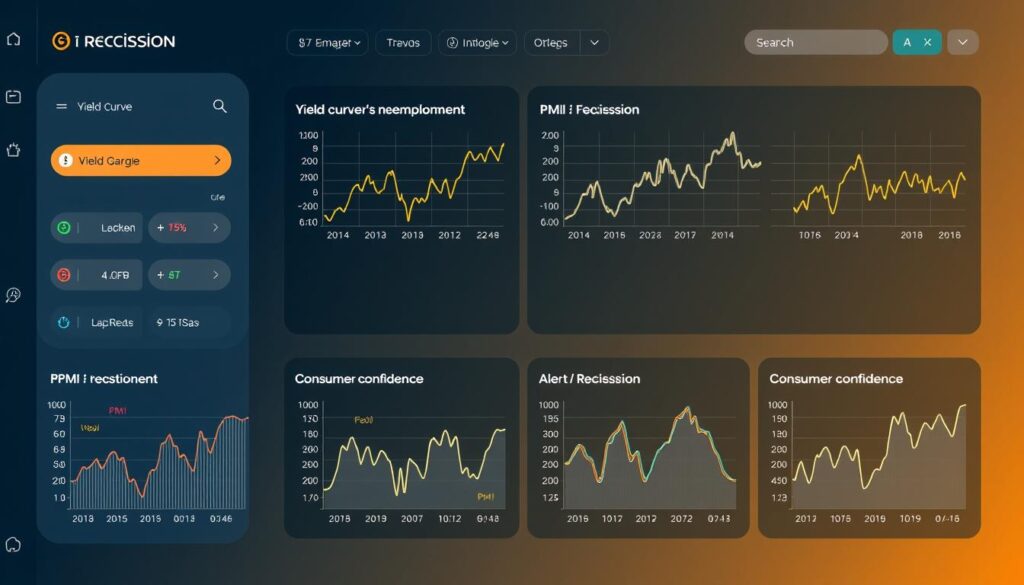
Staying informed about economic developments can help you adjust your preparation strategies as conditions evolve. Pay particular attention to these leading indicators:
Yield Curve
The relationship between short-term and long-term Treasury yields provides important signals about economic expectations. An inverted yield curve (when short-term rates exceed long-term rates) has historically preceded recessions.
Current status: The yield curve has shown periods of inversion but has recently steepened, sending mixed signals about recession probability.
Purchasing Managers’ Indices (PMI)
These surveys of manufacturing and services businesses provide early insights into economic activity. Readings below 50 indicate contraction, while values above 50 signal expansion.
Current status: Manufacturing PMI has shown weakness, while services PMI has remained more resilient, creating a mixed economic picture.
Unemployment Claims
Initial jobless claims often rise before broader unemployment increases. Watch for sustained increases in weekly claims as an early warning sign.
Current status: Claims have begun rising but remain relatively low by historical standards, suggesting the labor market remains fairly healthy.
Consumer Confidence
Consumer spending drives approximately 70% of U.S. economic activity. Declining confidence often precedes reduced spending and economic contraction.
Current status: Confidence measures have shown volatility, with the University of Michigan consumer sentiment falling 18.2% between December 2024 and June 2025.
Leading Economic Index
The Conference Board’s Leading Economic Index combines multiple indicators to provide a comprehensive view of future economic activity.
Current status: The index has shown modest declines, suggesting slower growth but not necessarily an imminent recession.
Credit Conditions
Tightening lending standards and rising delinquency rates often precede broader economic weakness. Monitor bank lending surveys and consumer credit reports.
Current status: Delinquency rates on credit cards and auto loans have increased, suggesting some consumer segments are experiencing financial stress.
Expert Perspectives on the 2025 Economic Outlook
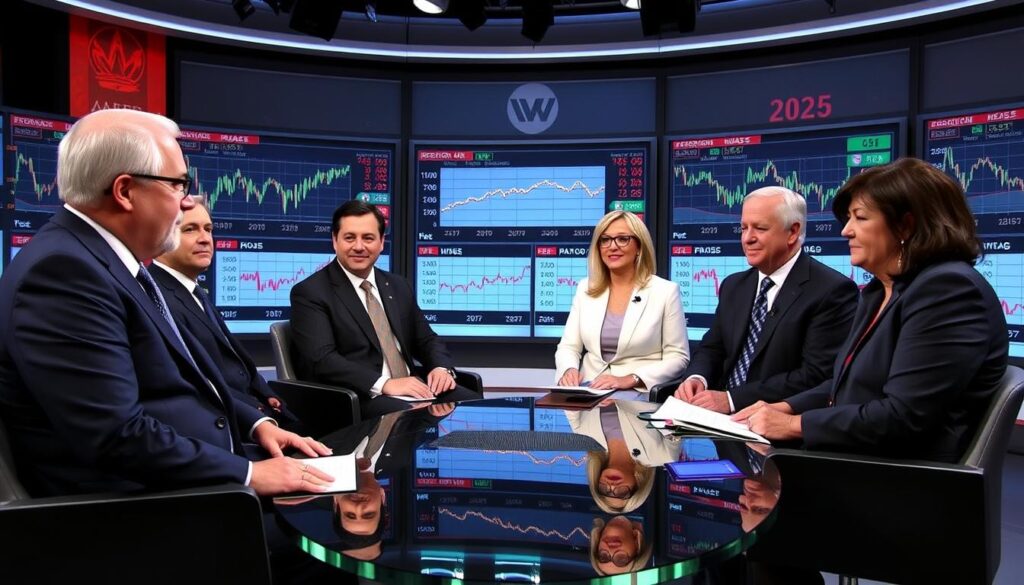
Leading economists and financial experts offer varying perspectives on the likelihood and potential severity of a 2025 recession. Understanding these diverse viewpoints provides valuable context for your preparation strategies.
“After posting a 1.5% decline in the first quarter of 2025, we predict investment in structures will continue to fall into the first quarter of 2026. Overall, we predict investment in structures to fall 1.6% in 2025 and 0.9% in 2026.”
“What’s unique about this Recession Watch is that, to a large degree, it primarily depends on incoming policy. A recession is thus entirely avoidable. If the policies outlined above are pared back or phased in more gradually, they are unlikely to trigger one.”
“The Fed’s hesitance to cut rates quickly is due to the inflationary impulse of tariffs, which bring the core PCE price deflator up to 3.6% on a year-over-year basis by the fourth quarter of 2025. The inflationary impulse proves to be temporary, allowing the Fed to cut rates slowly throughout 2026.”
While experts disagree on the probability and timing of a potential recession, most acknowledge that economic growth is likely to slow significantly. The consensus view suggests that policy decisions regarding tariffs, government spending, and monetary policy will play crucial roles in determining whether slower growth evolves into an actual recession.
Frequently Asked Questions About the 2025 Recession

Is a recession in 2025 inevitable?
No, a recession is not inevitable. While several risk factors exist, economic outcomes depend significantly on policy decisions, global developments, and how businesses and consumers respond to changing conditions. Many economists have reduced their recession probability estimates, though significant risks remain.
How might a 2025 recession differ from previous downturns?
A potential 2025 recession would likely have unique characteristics compared to previous downturns. It could be more policy-driven than previous recessions, particularly influenced by trade and tariff decisions. Some economists also warn about the possibility of “stagflation” – a combination of economic contraction and persistent inflation – which would differ from the deflationary recessions seen in recent decades.
Should I delay major purchases or investments until after 2025?
Major financial decisions should be based on your personal circumstances rather than attempting to time economic cycles. However, it’s prudent to ensure any significant purchases or investments align with your long-term financial plan and that you maintain adequate liquidity to weather potential economic challenges. For major purchases like homes or vehicles, consider how the purchase would impact your financial stability if your income were reduced.
How might different industries be affected by a potential recession?
Economic downturns typically impact industries differently. Sectors most vulnerable to a 2025 recession would likely include manufacturing (particularly those dependent on international supply chains), consumer discretionary, and commercial real estate. More resilient sectors typically include healthcare, consumer staples, utilities, and certain technology segments. The specific impact of tariffs and trade policies could create unique industry effects compared to previous recessions.
How long might a 2025 recession last?
The duration of recessions varies significantly. In Deloitte’s downside scenario, they project that “the US enters a recession in the fourth quarter of 2025 and does not return to its prerecession level of real GDP until early 2027,” suggesting a potential duration of approximately 15 months. However, policy responses, particularly monetary and fiscal measures, could significantly influence both the severity and duration of any economic contraction.
Preparing Now for Economic Uncertainty

While economic forecasts remain mixed regarding a potential 2025 recession, the consensus points to a period of slower growth and increased volatility. Rather than focusing solely on whether a technical recession will occur, the prudent approach is to strengthen your financial position to withstand economic challenges while remaining positioned to benefit from eventual recovery.
The strategies outlined in this article provide a framework for both defensive protection and opportunistic positioning. By building emergency reserves, reducing high-interest debt, diversifying investments, and developing contingency plans, individuals and businesses can navigate economic uncertainty with greater confidence.
Remember that economic cycles are normal, and downturns eventually give way to new periods of growth. Those who prepare thoughtfully often emerge from challenging periods in stronger positions relative to those who fail to adapt.
Stay Informed About Economic Developments
Subscribe to our monthly economic briefing to receive updates on recession indicators, expert analysis, and preparation strategies.

Adam G
This post was created by Adam G, a seasoned financial writer with a passion for explaining currency exchange and market movements
